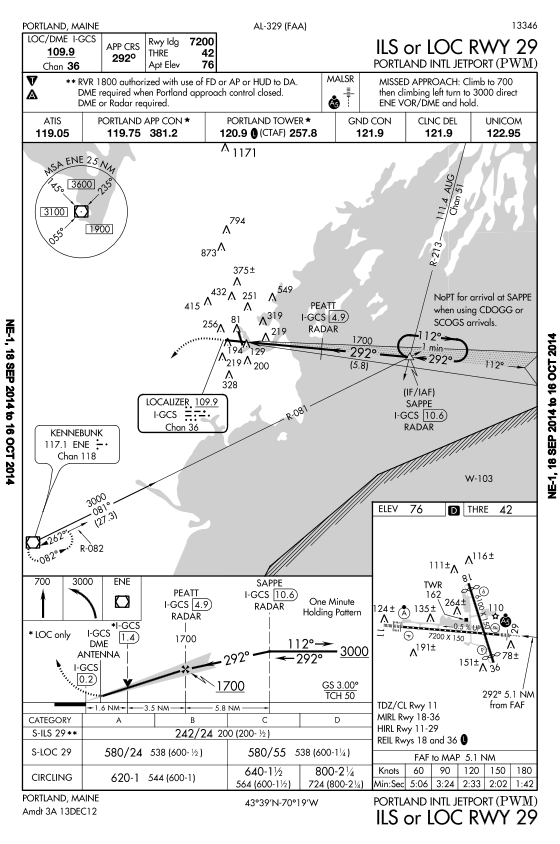We see from the profile view that we must maintain 3,000 feet until passing SAPPE inbound on the approach. At this point, we can descend to 1,700 feet and expect to intercept the glide slope at PEATT. Since the tower is closed, we would make traffic calls during the approach, landing, and taxi in. We must also remember to close our flight plan. If we are in VFR conditions, we can close our flight plan while airborne with a call to center. Otherwise, we will have to call the flight service station and cancel after landing.
If we were to conduct this same approach as the localizer approach instead of the ILS, the procedure would be fairly similar. Instead of following the glide slope from PEATT to the DA, we would cross PEATT at 1,700 feet and then descend to the appropriate MDA. Let's say we're conducting a straight in to runway 29 and flying the approach at 100 knots, which places us in Category B. In this case, we would descend to the MDA of 580 feet and look for the same items listed in FAR 91.175.
Another important part of 91.175 is that in order to land, the aircraft must continuously be in a position so that a landing can be made on the intended runway using a normal rate of descent and normal maneuvers. This means we can't spot the runway at the last minute and try to put on an airshow trying to get down to the runway.
To help us out with this, a visual descent point is shown in the profile view. This VDP, located at the I-GCS 1.4 DME, is the point from which a normal descent may be commenced. If you start down prior to this point, you will be low. If you pass this point, you are going to be high. VDP's apply to the straight in landing only. If you were circling to runway 11, for example, you would not reference this VDP. The asterisk links the VDP to a note, which reminds us the VDP is only to be used with the localizer approach. You wouldn't use it with the ILS, since that approach provides you a glide slope.
Another thing to consider is what to do if part of the approach system becomes inoperative. For an ILS, if the localizer is inoperative, you can't use the approach. You have to have lateral guidance for an approach. Should the glide slope of an ILS become inoperative, however, you still have the option of shooting the localizer approach. In the event this happens, the air traffic control phraseology can be a little confusing. Sometimes air traffic control will tell you "cleared localizer runway 23R approach", which makes things easy to understand. However, you could get a clearance such as "cleared ILS runway 23R, glide slope inoperative". In this case, you are also cleared to conduct the localizer approach.
For other inoperative components for an approach, we can consult the inoperative components table, which is found in each approach charts booklet. Should the approach lighting system be inoperative for our approach to runway 29 at Portland, the inoperative components table tells us we can still use the ILS approach. We would just increase the visibility minimums by ¼ miles, which is equal to 1600 RVR. In our example, we could shoot the ILS to runway 29 with the MALSR inoperative, so long as we had 4000 RVR or ¾ SM visibility.
